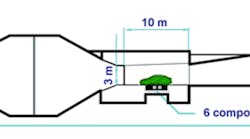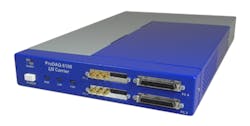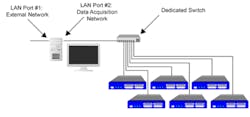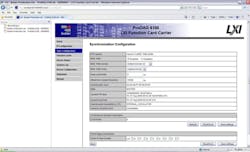LXI Data-Acquisition System for Wind Tunnel Testing
Wind tunnel facilities provide the equipment and expertise to develop and conduct tests used to characterize the aerodynamic and propulsion parameters of aircraft and vehicles. The S10 wind tunnel testing facility at the Institute Aérotechnique of the Conservatoire National des Arts et Métiers in France, was designed for full-scale automobile tests but has been modified several times to be adapted to other fields of studies.
The heart of the wind tunnel is its large test section measuring 5 meters x 3 meters x 10 meters (Figure 1) used to perform a variety of tests including force tests, pressure tests, and airflow pattern measurements. The test section of the S10 wind tunnel has a maximum flow velocity of 55 m/s (200 km/h) and is equipped with a broad range of test equipment including six of Bustec’s ProDAQ 6100 function card carriers.
Figure 1. Illustration of Wind Tunnel at Institut AéroTechnique in France
LXI-Based DAQ System
The ProDAQ 6100 (Figure 2) is an LXI-compliant function card carrier that supports all LXI core features via a Gigabit LAN interface and a number of LXI extended functions, such as LXI clock synchronization and the LXI wired trigger bus (WTB).
Figure 2. ProDAQ 6100 LXI Function Card Carrier
Each of the card carriers is equipped with two ProDAQ 3424 eight-channel, 24-bit ADC function cards used to measure nonstationary pressure generated by sensors at the UUT at a sample speed of up to 216 kS/s per channel. The acquired data is timestamped and transferred via Gigabit Ethernet to a PC for storage and visualization.
LXI Clock Synchronization
LXI clock synchronization inherits IEEE 1588-2008, a protocol used to synchronize real-time clocks with submicrosecond accuracy in devices of a networked distributed system.
The card carrier uses sophisticated control algorithms in software and dedicated hardware for registering timestamps of both incoming and outgoing Ethernet packets. It can operate as master or slave and allows the internally generated clock of 100 MHz to be synchronized with high precision. A base clock used on the function cards for data acquisition and generation is derived from this synchronized clock with a phase jitter of about 20 ns, which is equivalent to hardware clock synchronization used in non-1588 systems.
LXI Wired Trigger Bus
The LXI WTB is a hard-wired interface that offers input or output configurability, wired-OR, and shielding and cabling for the most demanding triggering applications. This method of triggering increases measurement accuracy to the nanosecond range compared to software triggering via the LAN, which typically is in the millisecond range.
Ethernet-Based Trigger Distribution and Synchronization
After allowing the clocks on all of the LXI carriers to synchronize, the data acquisition is started simultaneously on all of the function cards. Instead of transferring the data to the host PC, it is stored in a circular buffer available on the card carrier. Based on a trigger received via the front-panel trigger input or derived from the analog data by a programmable level and slope, the function cards are programmed to forward triggers to the card carrier.
Each trigger is timestamped, and the data is sent to the host PC. The host PC distributes the timestamp back to all participating card carriers and function cards which, in turn, stops the usage of the circular buffer and starts the normal data streaming to the host starting from the exact data point related to the trigger event.
High-Bandwidth Network Configuration
To achieve the desired data throughput, the carriers are connected to a dedicated subnet that uses a Gigabit switch with two 10-Gbit uplink ports (Figure 3). The acquired data is transferred to the host PC in binary form via the jumbo frames supported in most Gigabit Ethernet switches and adapters. For 96 channels sampled at 216 kS/s per channel, the raw data amounts to 82,944,000 bytes/s. The remaining bandwidth is used for the message/packet overhead and IEEE 1588 synchronization.
Figure 3. Ethernet-Based DAQ System
Using dedicated subnets for LXI-based DAQ applications guarantees the availability of network bandwidth for continuous data streaming and easy scalability.
Configuration of the LXI carriers is accomplished via a built-in standardized web interface (Figure 4). This remote-access capability is suitable for wind tunnel testing where test engineers can access acquired data from any location.
Figure 4. Built-In LXI Web Interface of ProDAQ 6100
Summary
Wind tunnel testing requires DAQ systems with high-channel counts capable of acquiring sampled data continuously over long periods of time and reliably transferring the data to a host PC where it is processed and stored. Bustec’s LXI-based DAQ system provides 96 channels capable of acquiring test data from the wind tunnel at a speed of 216 kS/s per channel with high-precision synchronization and real-time event triggering for transfer to the PC over Gigabit Ethernet. As an LXI-compliant device, Bustec’s ProDAQ 6100 carrier includes a built-in web interface to enable configuration and troubleshooting as well as auto-discovery tools to minimize development time. With LXI, it is possible to perform remote execution, monitoring, and debugging, which are necessary for harsh wind tunnel environments.
About the Author
Fred Bloennigen, Ph.D., is CEO of Bustec. He earned a doctorate in physics in France and later was employed at the University of California/Berkeley as a nuclear and elementary particle physicist. Back in Europe, he worked for a large American data-acquisition and test company for several years. Dr. Bloennigen founded Bustec in Ireland in 1997 and opened a branch in the United States in 2000. [email protected]




